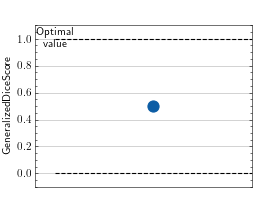Generalized Dice Score¶
Module Interface¶
- class torchmetrics.segmentation.GeneralizedDiceScore(num_classes, include_background=True, per_class=False, weight_type='square', input_format='one-hot', **kwargs)[source]
Compute Generalized Dice Score.
The metric can be used to evaluate the performance of image segmentation models. The Generalized Dice Score is defined as:
\[\begin{split}GDS = \frac{2 \\sum_{i=1}^{N} w_i \\sum_{j} t_{ij} p_{ij}}{ \\sum_{i=1}^{N} w_i \\sum_{j} t_{ij} + \\sum_{i=1}^{N} w_i \\sum_{j} p_{ij}}\end{split}\]where \(N\) is the number of classes, \(t_{ij}\) is the target tensor, \(p_{ij}\) is the prediction tensor, and \(w_i\) is the weight for class \(i\). The weight can be computed in three different ways:
square: \(w_i = 1 / (\\sum_{j} t_{ij})^2\)
simple: \(w_i = 1 / \\sum_{j} t_{ij}\)
linear: \(w_i = 1\)
Note that the generalized dice loss can be computed as one minus the generalized dice score.
As input to
forwardandupdatethe metric accepts the following input:preds(Tensor): An one-hot boolean tensor of shape(N, C, ...)withNbeing the number of samples andCthe number of classes. Alternatively, an integer tensor of shape(N, ...)can be provided, where the integer values correspond to the class index. The input type can be controlled with theinput_formatargument.target(Tensor): An one-hot boolean tensor of shape(N, C, ...)withNbeing the number of samples andCthe number of classes. Alternatively, an integer tensor of shape(N, ...)can be provided, where the integer values correspond to the class index. The input type can be controlled with theinput_formatargument.
As output to
forwardandcomputethe metric returns the following output:gds(Tensor): The generalized dice score. Ifper_classis set toTrue, the output will be a tensor of shape(C,)with the generalized dice score for each class. Ifper_classis set toFalse, the output will be a scalar tensor.
- Parameters:
num_classes¶ (
int) – The number of classes in the segmentation problem.include_background¶ (
bool) – Whether to include the background class in the computationper_class¶ (
bool) – Whether to compute the metric for each class separately.weight_type¶ (
Literal['square','simple','linear']) – The type of weight to apply to each class. Can be one of"square","simple", or"linear".input_format¶ (
Literal['one-hot','index','mixed']) – What kind of input the function receives. Choose between"one-hot"for one-hot encoded tensors,"index"for index tensors or"mixed"for one one-hot encoded and one index tensorkwargs¶ (
Any) – Additional keyword arguments, see Advanced metric settings for more info.
- Raises:
ValueError – If
num_classesis not a positive integerValueError – If
include_backgroundis not a booleanValueError – If
per_classis not a booleanValueError – If
weight_typeis not one of"square","simple", or"linear"ValueError – If
input_formatis not one of"one-hot","index"or"mixed"
Example
>>> from torch import randint >>> from torchmetrics.segmentation import GeneralizedDiceScore >>> gds = GeneralizedDiceScore(num_classes=3) >>> preds = randint(0, 2, (10, 3, 128, 128)) >>> target = randint(0, 2, (10, 3, 128, 128)) >>> gds(preds, target) tensor(0.4992) >>> gds = GeneralizedDiceScore(num_classes=3, per_class=True) >>> gds(preds, target) tensor([0.5001, 0.4993, 0.4982]) >>> gds = GeneralizedDiceScore(num_classes=3, per_class=True, include_background=False) >>> gds(preds, target) tensor([0.4993, 0.4982])
- plot(val=None, ax=None)[source]
Plot a single or multiple values from the metric.
- Parameters:
val¶ (
Union[Tensor,Sequence[Tensor],None]) – Either a single result from calling metric.forward or metric.compute or a list of these results. If no value is provided, will automatically call metric.compute and plot that result.ax¶ (
Optional[Axes]) – An matplotlib axis object. If provided will add plot to that axis
- Return type:
- Returns:
Figure and Axes object
- Raises:
ModuleNotFoundError – If matplotlib is not installed
>>> # Example plotting a single value >>> import torch >>> from torchmetrics.segmentation import GeneralizedDiceScore >>> metric = GeneralizedDiceScore(num_classes=3) >>> metric.update(torch.randint(0, 2, (10, 3, 128, 128)), torch.randint(0, 2, (10, 3, 128, 128))) >>> fig_, ax_ = metric.plot()

>>> # Example plotting multiple values >>> import torch >>> from torchmetrics.segmentation import GeneralizedDiceScore >>> metric = GeneralizedDiceScore(num_classes=3) >>> values = [ ] >>> for _ in range(10): ... values.append( ... metric(torch.randint(0, 2, (10, 3, 128, 128)), torch.randint(0, 2, (10, 3, 128, 128))) ... ) >>> fig_, ax_ = metric.plot(values)

Functional Interface¶
- torchmetrics.functional.segmentation.generalized_dice_score(preds, target, num_classes, include_background=True, per_class=False, weight_type='square', input_format='one-hot')[source]
Compute the Generalized Dice Score for semantic segmentation.
- Parameters:
include_background¶ (
bool) – Whether to include the background class in the computationper_class¶ (
bool) – Whether to compute the score for each class separately, else average over all classesweight_type¶ (
Literal['square','simple','linear']) – Type of weight factor to apply to the classes. One of"square","simple", or"linear"input_format¶ (
Literal['one-hot','index','mixed']) – What kind of input the function receives. Choose between"one-hot"for one-hot encoded tensors,"index"for index tensors or"mixed"for one one-hot encoded and one index tensor
- Return type:
- Returns:
The Generalized Dice Score
- Example (with one-hot encoded tensors):
>>> from torch import randint >>> from torchmetrics.functional.segmentation import generalized_dice_score >>> preds = randint(0, 2, (4, 5, 16, 16)) # 4 samples, 5 classes, 16x16 prediction >>> target = randint(0, 2, (4, 5, 16, 16)) # 4 samples, 5 classes, 16x16 target >>> generalized_dice_score(preds, target, num_classes=5) tensor([0.4830, 0.4935, 0.5044, 0.4880]) >>> generalized_dice_score(preds, target, num_classes=5, per_class=True) tensor([[0.4724, 0.5185, 0.4710, 0.5062, 0.4500], [0.4571, 0.4980, 0.5191, 0.4380, 0.5649], [0.5428, 0.4904, 0.5358, 0.4830, 0.4724], [0.4715, 0.4925, 0.4797, 0.5267, 0.4788]])
- Example (with index tensors):
>>> from torch import randint >>> from torchmetrics.functional.segmentation import generalized_dice_score >>> preds = randint(0, 5, (4, 16, 16)) # 4 samples, 5 classes, 16x16 prediction >>> target = randint(0, 5, (4, 16, 16)) # 4 samples, 5 classes, 16x16 target >>> generalized_dice_score(preds, target, num_classes=5, input_format="index") tensor([0.1991, 0.1971, 0.2350, 0.2216]) >>> generalized_dice_score(preds, target, num_classes=5, per_class=True, input_format="index") tensor([[0.1714, 0.2500, 0.1304, 0.2524, 0.2069], [0.1837, 0.2162, 0.0962, 0.2692, 0.1895], [0.3866, 0.1348, 0.2526, 0.2301, 0.2083], [0.1978, 0.2804, 0.1714, 0.1915, 0.2783]])
